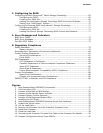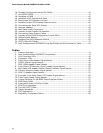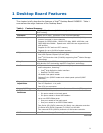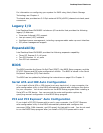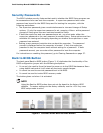
Desktop Board Features
15
Main Memory
NOTE
To be fully compliant with all applicable Intel
®
SDRAM memory specifications, the
board should be populated with DIMMs that support the Serial Presence Detect (SPD)
data structure. If your memory modules do not support SPD, you will see a
notification to this effect on the screen at power up. The BIOS will attempt to
configure the memory controller for normal operation.
The Desktop Board supports the following memory and interface:
• Six 240-pin Double Data Rate 3 (DDR3) SDRAM Dual Inline Memory Module (DIMM)
connectors with gold-plated contacts arranged in three channels
• 1600+/1333/1066/800 MHz DDR3 SDRAM Memory Modules
NOTE
DDR3 1600 or higher memory support on this desktop board requires
compatible XMP-enabled memory or advanced knowledge of BIOS and
manual memory tuning. Individual results may vary.
• Support for single-, dual-, and triple-channel memory interleaving
• Unbuffered, non-registered single or double-sided DIMMs with a voltage rating of
1.65 V or less
NOTE
Using a DIMM with a voltage rating higher than 1.65 V may damage the
processor.
• ECC and non-ECC DDR3 memory
• Serial Presence Detect (SPD) memory only
• Up to 24 GB maximum total system memory
NOTE
32-bit operating systems are limited to a maximum of 4 GB of memory. The
operating system report less than 4 GB because of the memory used by add-in
graphics cards.
Go to the following links or pages for more information about:
• SDRAM specifications, http://www.intel.com/technology/memory/
• Installing memory, page 40 in Chapter 2



